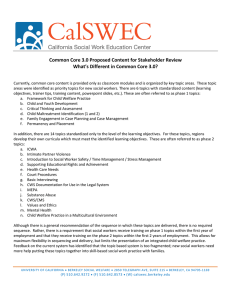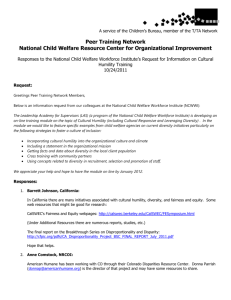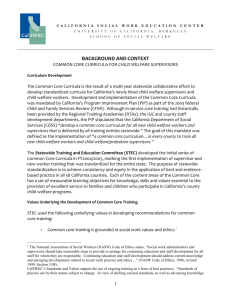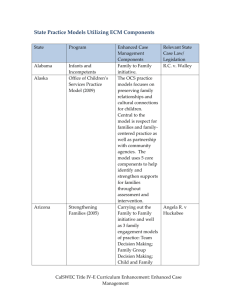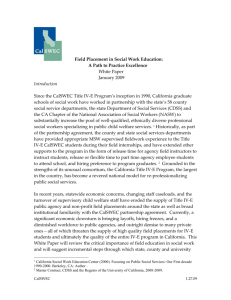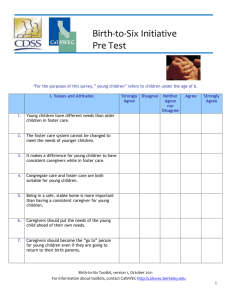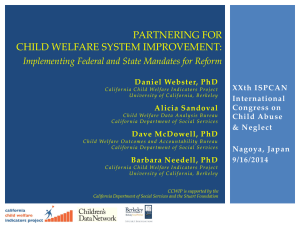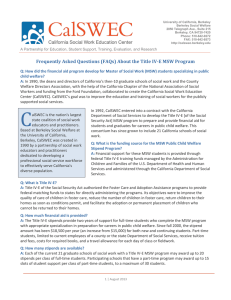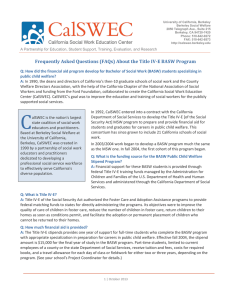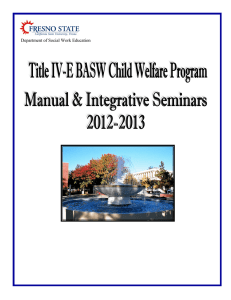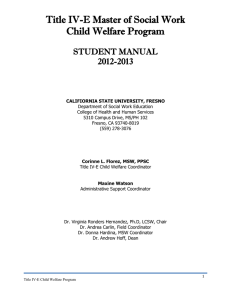Evaluating a Large and Complex Training System
advertisement
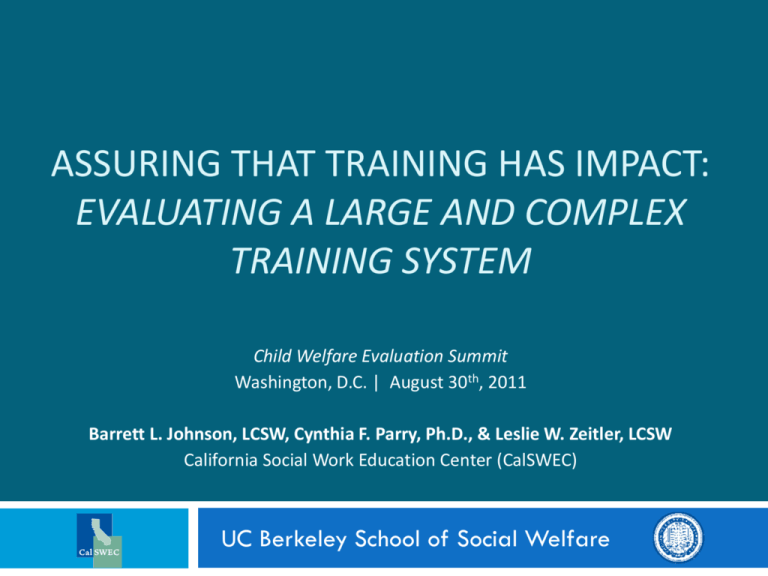
ASSURING THAT TRAINING HAS IMPACT: EVALUATING A LARGE AND COMPLEX TRAINING SYSTEM Child Welfare Evaluation Summit Washington, D.C. | August 30th, 2011 Barrett L. Johnson, LCSW, Cynthia F. Parry, Ph.D., & Leslie W. Zeitler, LCSW California Social Work Education Center (CalSWEC) UC Berkeley School of Social Welfare Objectives 2 At the close of the workshop participants will: Understand the benefits and uses of system wide training evaluation data. Understand the bases for decisions about the training evaluation system’s purpose, design, scope, and standardization. Apply concepts from the workshop to planning evaluation systems in their own states. Why evaluate child welfare training? 3 Most practice improvement initiatives involve training. We spend a great deal of funds on training. Very few training programs systematically assess the impact of training on trainees’ knowledge, skills, or ability to transfer the skills to the job. “The tail wags the dog” – Evaluation forces the entire system to focus on what specific knowledge, skills and values are most essential to effective practice. 4 Key Partners in California’s Child Welfare In-Service Training Evaluation Importance to Practice Community… 5 Why are training evaluation efforts important to practitioners and administrators? Must assure that they meet regulations Allow them to participate in curriculum review and revision and make adjustments to content Assures them that the workforce is prepared Gives them structure for supporting Transfer of Learning Makes the link to outcomes Key Steps 6 2001 - Macro Evaluation Team convenes, begins planning. 2002 - PIP mandates development & Implementation of Framework for Training Evaluation [1] 2004 – Framework Completed and Adopted 2004 to 2009 – Partners implement Framework Late 2008/Early 2009 – Begin Strategic Planning process for next 2-year period Fall 2009 – Implementation of next strategic plan commences Fall 2011 – Process begins on next strategic plan [1] Parry, C. & Berdie, J. (2004). Training evaluation framework report. Berkeley, CA: California Social Work Education Center. Timeline of Activities 7 2001 Macro Eval Team Convenes 2009 Strategic Planning begins Today 2001 - 2004 Formulation of Framework 2002 2001 2003 2004 2004 - 2009 Initial Framework Implementation 2005 2006 2007 2008 2009 - 2012 Next Plan Implemented 2009 2010 2011 2012 2012 Framework Decision Points 8 What is the purpose of the evaluation? Providing feedback System or course improvement Staff learning/skill mastery Accountability Documentation of training effectiveness Evidence of individual competence Supporting planning and decision-making Program development Individual needs/skill gaps Framework Decision Points 9 How rigorous will the evaluation need to be to ensure valid decisions? Stakes/consequences for participants What will be the focus/scope of the evaluation? Training system Course or series of courses Content area Specific KSA/learning objective Framework Decision Points (cont.) 10 What level(s) of evaluation are desired? What level of standardization is desired or required? How will results be disseminated, to whom, how often and for what purposes? Who are the audiences for the information? What are the best methods for dissemination? Best timetables? What are appropriate and inappropriate uses for the data? How will confidentiality and/or protection of human subjects be addressed? Framework Decision Points (cont.) 11 What resources are available/needed? Dollars Evaluator skills Staff time Training related to implementation of the evaluation Data tracking, entry, storage, QA Framework Decisions in California 12 Purpose/Use = Program/course improvement Focus/scope = Content area Priority content areas: Assessment of Safety, Risk & Protective Capacity Engaging Families in Case Planning & Mgmt Human Development Placement/Permanence Child Maltreatment Identification Evaluation Rigor No reporting of individual results except in LA No personnel consequences attached Careful attention to validity of measurement tools Multiple levels of item review Statistical item analysis Analysis of DIF Rasch Modeling used to build item bank and allow interpretation across multiple years, test and curriculum versions Framework Decisions in CA 14 Levels of Evaluation Level 1: Tracking attendance (Demographics) Level 2: Formative evaluation of training courses (course level: curriculum content & methods) Level 3: Satisfaction and opinion of the trainees Level 4: Trainee knowledge acquisition Level 5: Skills acquisition (as demonstrated in class) Level 6: Transfer of learning (TOL: use of knowledge and skill on the job) Level 7: Agency/client outcomes (degree to which training affects achievement of specific agency goals or client outcomes) Framework Decisions in CA 15 Levels of Training Evaluation (cont.) Key concept: Chain of Evidence Establishes a linkage between training and desired outcomes for the participant, the agency, and the client such that a reasonable person would agree that training played a part in producing the desired outcome. Framework Decisions in CA 16 Levels of Standardization Establishes standard competencies and learning objectives for the whole core Establishes six core areas where information is standard (5 are evaluated at knowledge level) Establishes one core area (Child Maltreatment Identification) where delivery and information is standard (Evaluated at skill level) Venn Diagram of Standardization 17 Child Maltreatment ID •Standard learning objectives and competencies •Standardized information •Standardized delivery •Embedded skill evaluation Child MalTreatment ID 5 Other Priority Areas • Standard learning objectives and competencies • Standardized information • Knowledge evaluation Other content • Standard learning objectives and competencies 5 other Priority Areas Other content in core Framework Decisions in California 18 Dissemination of Results Guided by Human Subjects considerations Multiple reports for multiple audiences: Statewide organizations Regional Training Academies Trainers and Administrators Resources = Intensive, multi-year commitment CalSWEC staff time; staff time from state, regional, and private partners; evaluation consultant services; hardware and software. Let’s see how far we’ve come… 19 20 What do we know now? (Summary of Progress/Results by Level) Level 1: Demographic data captured for 5,253 new child welfare social workers and 663 supervisors since formal evaluations began in 2005 (data thru 6/30/11). Level 2: Collected and analyzed data on training content and delivery, resulting in improvements to the Common Core. Level 3: This level of evaluation is completed at a regional level, and not on a statewide basis. Summary of Progress/Results, cont’d 21 Level 4: Knowledge Tests For topics in which knowledge pre- and post-tests were administered (Child & Youth Dev; Case Planning & Case Management, and Placement & Permanency): Trainees (new CWWs) improved from pre-to posttest at a statistically significant level. Summary of Progress/Results, cont’d Level 4, continued: IV-E Effects– IV-E trainees have scored higher at pre and posttest Posttest score differences have been statistically significant for all modules over the past 2 fiscal years, and for two of the three modules since January of 2007. IV-E trainees achieved significant gains from pre to posttest Summary of Progress/Results, cont’d 23 Level 4, continued: For the topic in which a knowledge post-test only has been administered (Critical Thinking in Child Welfare Assessment: Safety, Risk & Protective Capacity): Although no formal standard has been established that serves as a yardstick of mastery, the data indicates that trainees leave the classroom with a substantial level of knowledge related to the learning objectives for the course. Summary of Progress/Results, cont’d 24 Level 5: For topics in which skill is assessed in the classroom (e.g., embedded evaluation) that pertains to identification of physical abuse and sexual abuse (Child Maltreatment Identification, Parts 1 and 2): At least 87% (and in most years 90% or more) of new CWWs made 3 out of 4 correct decisions when asked to indicate whether or not child maltreatment occurred in a given case scenario. Summary of Progress/Results, cont’d 25 Level 6: Completed regional studies on Transfer and Field Training. (See 2009 White Paper, noted at end of this PPT.) Level 7: Under the Framework, efforts have focused on developing the building blocks at the lower levels in a rigorous manner (as part of developing a chain of evidence). Overarching goal is to link training interventions to outcomes for children and families served by CWS. Sample Report 26 Review Statewide Trainer/Administrator Report (June 2011) Where are We Going? 27 Where Are We Going (by Level)? 28 Level 1: Lineworker Core: Demographic profiles and related analyses of lineworker core test data will continue. Supervisor Core: Demographic profiles and related analyses of supervisor core test data will commence. Analyses of IV-E trainee test data. Where Are We Going? (cont’d…) 29 Level 2: Formative evaluations for observers (and separate ones for trainers) will be divided into assessments of content and assessments of delivery. Formative evaluation materials also will be developed for a new statewide venture: the elearning platform. Level 3: These efforts will continue solely at the regional and county levels. Where Are We Going? (cont’d…) 30 Level 4: Continue knowledge tests (consists of multiple choice test questions, aka “test items”) for the curricula currently evaluated at this level. Move toward diagnostic testing: Focus on key learning objectives Make targeted revisions to training based on evaluation data. Where Are We Going? (cont’d…) 31 Level 4 (cont’d): Continue analysis of differential functioning by demographic groups. Pilot study to look at possible effect of stereotype threat in trainee test performance (PCWTA). Explore trainer-level differences in test item performance to provide feedback on fidelity of curriculum delivery. Compare/monitor differences in performance for Title IV-E vs. non-IV-E students. Where Are We Going? (cont’d…) 32 Level 5: Continue analysis of differential performance by demographic groups. Pilot the embedded eval of the SDMTM version of the Critical Thinking in Child Welfare Assessment: Safety, Risk & Protective Capacity curriculum. Revise the embedded evaluation for Casework Supervision module. Pilot neglect scenario as part of an embedded eval (PCWTA) Where Are We Going? (cont’d…) 33 Level 6: Conduct a feasibility study of Transfer of Learning evaluations as applied at a statewide level, based on findings and lessons learned from initial TOL evaluations. Level 7: • Continue building Chain of Evidence to link training to outcomes. • Conduct a feasibility study of linking training to outcomes evaluation as applied at a statewide level. (May link this to program evaluation efforts, or to research related to the Statewide Research Agenda for CWS.) Where Are We Going? (cont’d…) 34 Other training evaluation projects: Attitudes/Values Evaluation re: racial differences in identifying physical abuse. (PCWTA to pilot.) Attitudes/Values Evaluation re: impact of attitudes toward sexual abuse disclosures. (Collaboration with UNC School of Medicine.) Trainer Evaluation: Identify trainer-related differences in test item difficulty. Develop & obtain feedback on model of trainer evaluation. Quality Assurance: Small group of reps from around the state to observe one Phase 1 training and one Phase 2 training in each region. Exercise 35 1. 2. 3. Split into groups (dyads or triads) from different states Small group process: a. Consider the training system in your home state. Briefly discuss each of the six decision points, and answer the following questions: 1. Where is your state in the process of implementing a child welfare training evaluation system? (e.g. planning stages, early implementation, mature system, etc.) 2. What key decisions have you made with respect to each of the decision points? 3. What key decisions do you still need to make with respect to these decision points? How would you go about making them? Brief report out: What is the one take home point from your discussion that you would like to share? 36 We’re going to keep an eye on outcomes for children & families… For More Information… 37 Refer to the full text of the white paper entitled: Evaluation of the California Common Core for Child Welfare Training: Implementation Status, Results and Future Directions (December 2009), at: http://calswec.berkeley.edu/CalSWEC/CWTraining.html OR, refer to the summary table (of the white paper) entitled: Where We’ve Been and Where We’re Going: Summary Table of Training Evaluation Efforts in California (Dec 2009), also at: http://calswec.berkeley.edu/CalSWEC/CWTraining.html For more information on the original Framework, go to: http://calswec.berkeley.edu/CalSWEC/MacroEvalFrameworkReportFinal.pdf Parry, C. & Berdie, J. (2004). Training evaluation framework report. Berkeley, CA: California Social Work Education Center. http://calswec.berkeley.edu Barrett Johnson – barrettj@berkeley.edu Leslie Zeitler – lzeitler@berkeley.edu Cynthia Parry – CFParry@msn.com
